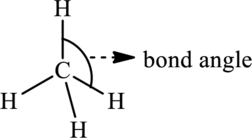
Concept explainers
(a)
Interpretation:
Bond angle in
Concept Introduction:
The bond angle is the angle formed between two bonded atoms in a covalent species. It decides the molecular geometry of a molecule. For example in molecule

The table that relates hybridization with % s character is as follows:
Bond angle is directly related to % s character in a molecule.
Hybridization is calculated by the hybrid orbitals and to calculate hybrid orbitals we need to know the steric number that is given by,
The table that relates the steric number with hybridization is as follows:
(b)
Interpretation:
Whether
Concept Introduction:
Refer to part (a).
Want to see the full answer?
Check out a sample textbook solution
Chapter 2 Solutions
Chemical Principles: The Quest for Insight
- It is possible to write a simple Lewis structure for the SO42- ion, involving only single bonds, which follows the octet rule. However, Linus Pauling and others have suggested an alternative structure, involving double bonds, in which the sulfur atom is surrounded by six electron pairs. (a) Draw the two Lewis structures. (b) What geometries are predicted for the two structures? (c) What is the hybridization of sulfur in each case? (d) What are the formal charges of the atoms in the two structures?arrow_forwardConsider the reaction BF3 + NH3 -> F3B-NH3 (a) Describe the changes in hybridization of the B and N atoms as a result of this reaction. (b) Describe the shapes of all the reactant molecules with their bond angles. (c) Draw the overall shape of the product molecule and identify the bond angles around B and N atoms. (d) What is the name of the bond between B and N. (e)Describe the bonding orbitals that make the B and F, B and N & N and H bonds in the product molecule.arrow_forwardA useful solvent that will dissolve salts as well as organic compounds is the compound acetonitrile, H3CCN. It is present in paint strippers.(a) Write the Lewis structure for acetonitrile, and indicate the direction of the dipole moment in the molecule.(b) Identify the hybrid orbitals used by the carbon atoms in the molecule to form σ bonds.(c) Describe the atomic orbitals that form the π bonds in the molecule. Note that it is not necessary to hybridize the nitrogen atom.arrow_forward
- For each statement, indicate whether it is true or false. (a) The greater the orbital overlap in a bond, the weaker the bond. [b] The greater the orbital overlap in a bond, the shorter the bond. [c] To create a hybrid orbital, you could use the s orbital on one atom with a p orbital on another atom. [d] Nonbonding electron pairs cannot occupy a hybrid orbital.arrow_forward7. Nitrogen is the central atom in each of the species given. (a) Draw the Lewis electron-dot structure for each of the species. + NO₂ NO₂ NO₂ (b) List the species in order of increasing bond angle. Justify your answer. (c) For NO₂ and NO₂, give the hybridization of the nitrogen atom in it. (d) Identify the only one of the species that dimerizes and explain what causes it to do so.arrow_forward. Assume that the third-period element phosphorus forms a diatomic molecule, P2, in an analogous way as nitrogen does to form N2. (a) Write the electronic configuration for P2. Use [Ne2] to represent the electron configuration for the first two periods. (b) Calculate its bond order. (c) What are its magnetic properties (diamagnetic or paramagnetic)?arrow_forward
- 1. Draw the Lewis structures for each of the following ions or molecules. For each, give (i) the molecular shape, (ii) the electron pair geometry at the central atom, and (iii) the hybridization of the central atom. (a) POF3 (b) XeO₂F3+ (c) BrCl₂ (d) N3 (the central atom is N; two other N's are bonded to it) (e) PF3arrow_forwardIn ozone, O3, the two oxygen atoms on the ends of the molecule are equivalent to one another. (a)What is the best choice of hybridization scheme for the atoms of ozone? (b) For one of the resonance forms of ozone, which of the orbitals are used to make bonds and which are used to hold nonbonding pairs of electrons? (c) Which of the orbitals can be used to delocalize the π electrons? (d) How many electrons are delocalized in the π system of ozone?arrow_forwardThe Lewis structure of BH2Cl (a) Is the molecule polar or nonpolar? (b) What is the hybridization of the carbon atom? (c) What is the geometric shape of the molecule?arrow_forward
- (a) Methane (CH4) and the perchlorate ion (ClO4- ) are bothdescribed as tetrahedral. What does this indicate about theirbond angles? (b) The NH3 molecule is trigonal pyramidal, while BF3 is trigonal planar. Which of these molecules is flat?arrow_forwardDraw the molecular orbital energy diagrams for the valence electrons in the following diatomic molecules. Calculate the bond order and indicate if each of them is diamagnetic or paramagnetic. (а) В> (b) С. (c) CO (d) NO (е) Оzarrow_forwardConsider the SCl2 molecule. (a) What is the electron configuration of an isolated S atom? (b) What is the electron configuration of an isolated Cl atom? (c) What hybrid orbitals should be constructed on the S atom to make the S-Cl bonds in SCl2 ? (d) What valence orbitals if any, remain unhybridized on the S atom in SCL2 ?arrow_forward
 Chemistry: Principles and ReactionsChemistryISBN:9781305079373Author:William L. Masterton, Cecile N. HurleyPublisher:Cengage Learning
Chemistry: Principles and ReactionsChemistryISBN:9781305079373Author:William L. Masterton, Cecile N. HurleyPublisher:Cengage Learning Chemistry: Principles and PracticeChemistryISBN:9780534420123Author:Daniel L. Reger, Scott R. Goode, David W. Ball, Edward MercerPublisher:Cengage Learning
Chemistry: Principles and PracticeChemistryISBN:9780534420123Author:Daniel L. Reger, Scott R. Goode, David W. Ball, Edward MercerPublisher:Cengage Learning

